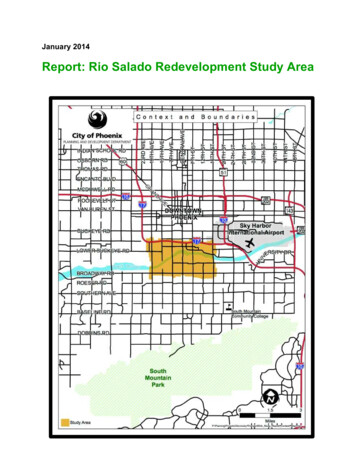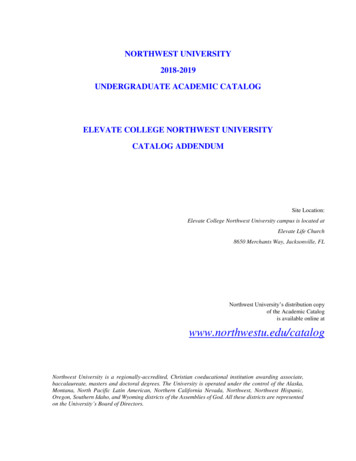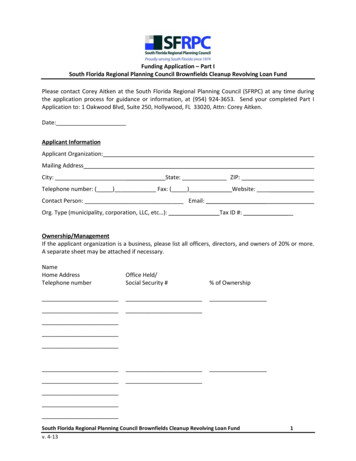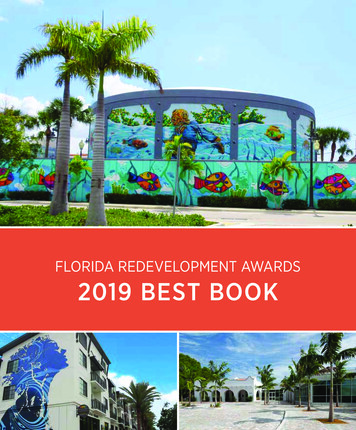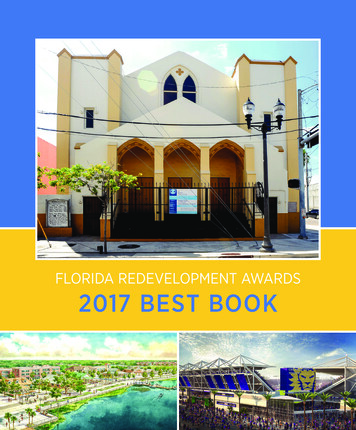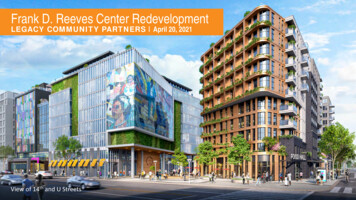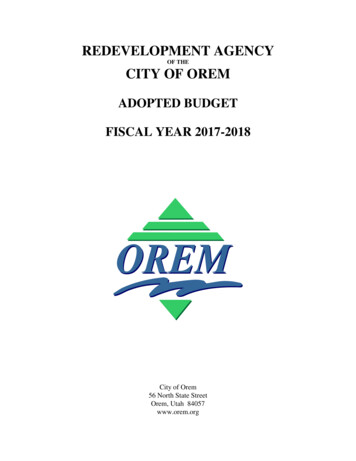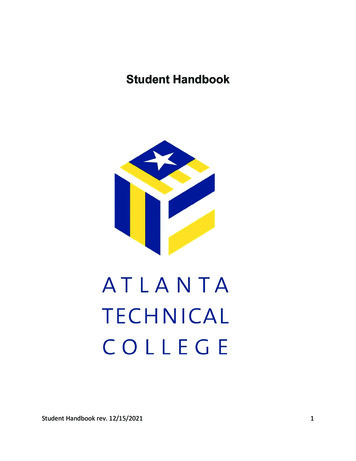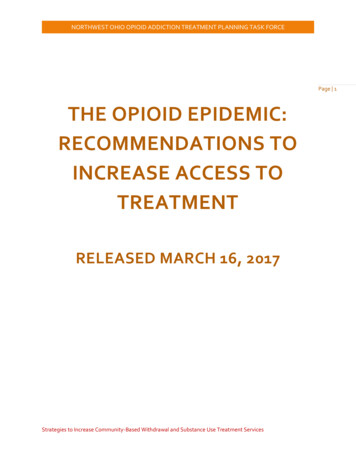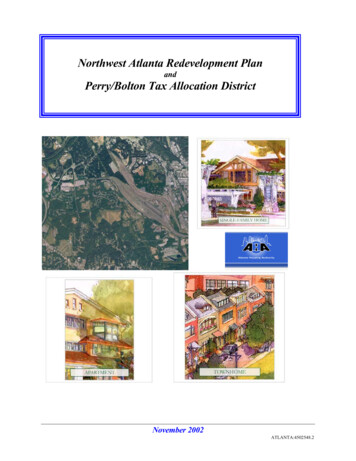
Transcription
Northwest Atlanta Redevelopment PlanandPerry/Bolton Tax Allocation DistrictNovember 2002ATLANTA:4502548.2
Northwest Atlanta Redevelopment Plan & Perry/Bolton Tax Allocation DistrictContentsEXECUTIVE SUMMARY . 4INTRODUCTION . 8Geographic Boundaries (A) . 8Northwest Atlanta: Existing Conditions . 9Atlanta Housing Authority: A Successful Community Builder . 11Atlanta’s Emphasis: Revitalized Communities & Sustainable Growth. 13Overview of Tax Allocation Districts. 14PROPOSAL . 15Grounds for Exercise of Redevelopment Powers (B). 15Northwest Atlanta Area Qualifies As a Redevelopment Area. 16Redevelopment Plan Vision & Goal. 17Hollywood Road Vision . 18Current Market Conditions . 19Demographics . 20Northwest Atlanta’s Potential: Future Growth & Development. 23Proposed Land Uses after Redevelopment (C). 23Proposed Redevelopment Projects (D) . 23West Highlands at Perry Boulevard. 23Other Redevelopment Projects . 25Carver Hills Neighborhood. 25Almond Park Neighborhood . 25Hollywood Road Corridor Improvements . 25Bolton/Marietta Livable Community Initiative . 26Brockbuilt Development Project. 26Brantley Street Development. 26General Shale Brickworks Development Project . 26Contractual Relationships (E) . 26Relocation Plans (F). 27Zoning & Land Use Compatibility (G). 27Method of Financing / Proposed Public Investments for TAD (H). 28Assessed Valuation for TAD (I) . 28“Revitalizing Northwest Atlanta with Sustainable Redevelopment”Page - 2 ATLANTA:4502548.2
Northwest Atlanta Redevelopment Plan & Perry/Bolton Tax Allocation DistrictHistoric Property within Boundaries of Redevelopment Area (J) . 29Creation & Termination Dates for TAD (K) . 29Tax Allocation Increment Base (M) . 29Property Taxes for Computing Tax Allocation Increments (N) . 30Tax Allocation Bond Issues (O, P, Q) . 30Amount of Bond Issue . 30Term of the Bond Issue or Issues. 30Rate of Bond Issue . 30Positive Tax Allocation Increments. 30Property to be Pledged for Payment of the Bonds. 31APPENDICES . 32Appendix A.1A.1B.2A.2B.3.4.5.6.7.8.9.10.11.12.Maps & DrawingsRedevelopment Plan Boundary Map (L)TAD Boundary MapRedevelopment Area Boundary Description (A)TAD Boundary DescriptionNorthwest Atlanta Existing Land Use (Map 3, Northwest Atlanta Framework Plan)Northwest Atlanta 15-year Land Use (Map 4, Northwest Atlanta Framework Plan)Northwest Atlanta Current Zoning (Map 5, Northwest Atlanta Framework Plan)Northwest Atlanta Flood Plain (Map 8, Northwest Atlanta Framework Plan)Northwest Atlanta Transportation Improvements (Map 30, Northwest AtlantaFramework Plan)Proposed Changes to CDP 15-year Land Use Plan (Map 32, Northwest AtlantaFramework Plan)West Highlands at Perry Project RenderingsList of Tax Parcel ID Numbers (Redevelopment Area)List of Tax Parcel ID Numbers (TAD)Redevelopment Projects MapAppendix B. . City of Atlanta Mayor & CouncilAppendix C. . Fulton County Board of CommissionersAppendix D. .Atlanta Board of EducationAppendix E. . Atlanta Housing Authority Board of CommissionersAppendix F. .Resources* Headings followed by a letter in parenthesis [e.g. (A)] denote information required per Georgia Code Chapter36, Title 44.“Revitalizing Northwest Atlanta with Sustainable Redevelopment”Page - 3 ATLANTA:4502548.2
Northwest Atlanta Redevelopment Plan & Perry/Bolton Tax Allocation DistrictExecutive SummaryThe City of Atlanta has invested heavily in planning for the revitalization of Northwest Atlantathrough sustainable redevelopment, most recently as outlined in its “Northwest AtlantaFramework Plan.”The Framework Plan calls for large-scale public-private partnerships to provide the economicturnaround the area so desperately needs. As a step in the implementation of that plan, theAtlanta Housing Authority and its private development partner, Perry Homes Redevelopment,LLC, have proposed such a partnership in the form of a 340 million revitalization of the formerPerry Homes housing development. While the Housing Authority has received HOPE VI fundsand other grants and investments, it must find a mechanism to fund construction of the newinfrastructure needed for the new development.To make these goals a reality, the City proposes the creation of the Northwest AtlantaRedevelopment Plan and Perry/Bolton Tax Allocation District.Approval of this proposed Northwest Atlanta Plan and Perry/Bolton TAD is importantfor the following reasons: To make possible the redevelopment of over 500 acres of real estate in theNorthwest Atlanta area that currently make a marginal economic and socialcontribution to the City. Development of the West Highlands at Perry projectwould transform vacant land and an area once filled with derelict properties andold apartments into a vibrant, mixed-use, mixed-income community that willimprove the economic standing of the City as proposed in the Northwest AtlantaFramework Plan. To make possible Northwest Atlanta’s first new Traditional NeighborhoodDevelopment, a model project to build interdependent neighborhoods that foster asafe, vibrant sense of community with pedestrian-friendly, mixed-use public andresidential redevelopments. This project should offer a new market that shouldfoster private commercial development. Traditional neighborhood developmentsbuild a sense of place, offering the greatest promise of success and longest-termimpact to any revitalized area. To build more than 1200 new homes in a variety of uses (single family, townhomes, apartments, senior rental apartments) that will convert the original 152acre Perry Homes site and nearby properties into a compatible mix of low-incometo market-rate rentals and owner-occupied units. This vibrant new residentialcommunity will serve residents of all incomes and ages, including affordableapartments for the elderly. It will attract a larger labor pool with the variety ofskills needed to bring new businesses into Northwest Atlanta and will provide thestimulus for development of new retail and service businesses in the area.“Revitalizing Northwest Atlanta with Sustainable Redevelopment”Page - 4 ATLANTA:4502548.2
Northwest Atlanta Redevelopment Plan & Perry/Bolton Tax Allocation District To provide funding for implementation of the Bolton/Marietta LCI plan and theHollywood Road vision and plan. To expand the residential base that will eventually enhance property and sales taxrevenues for the City of Atlanta, Fulton County, the Atlanta City schools and theState of Georgia. In addition to the homes developed within the original 152-acrePerry Homes site, new single family homes will be developed in other areas of theproposed TAD and the redevelopment area. To provide the incentive necessary to attract public and private investments ofmore than 350 million into Northwest Atlanta. West Highlands at Perry will addover 1200 new homes, a library, a YMCA recreational facility, a school and morethan 90 acres of green space, much for recreational use including trails, parks andan 18-hole PGA-caliber championship golf course. Improved transportation andrelated infrastructure, neighborhood-serving retail and other pedestrian-friendlyenhancements will attract more of the type of community-building investmentsthat are drawn to such developments. To provide funding for improvements in the Carver Hills and Almond Parkneighborhoods.“This area has ‘been depressed for so long’ that only a massive project could bethe catalyst to revive it.”- “Northwest renewal project to get revamp,” AJC, 7-29-02The ProblemCommunities in Northwest Atlanta face a host of redevelopment challenges: Significantly underused and vacant properties and run-down buildingsPerception of crimeConflict among land uses – residential, commercial and industrialConflict between residential and commercial/industrial trafficUninviting transportation arterialsLack of retail and neighborhood servicesAs identified in the City’s Northwest Atlanta plan, these challenges are balanced by opportunitieslike the area’s excellent location, proximity to employment centers and other amenities and anabundance of available land. However, the constraints to redeveloping this area, morespecifically the Perry Boulevard area, are also identified in the plan: “The floodplain andrough topographical constraints of some of the areas discourage development.” (p. 66)The challenge for the City is to find a way to convert this area’s challenges into opportunitieswith incentives that will spur community reinvestment.Demographics. The population in the proposed redevelopment area, as in all Northwest Atlanta,has suffered from a general lack of economic opportunity and investment. According to the2000 Census, the dates of construction of the housing structures recorded for the six tracts“Revitalizing Northwest Atlanta with Sustainable Redevelopment”Page - 5 ATLANTA:4502548.2
Northwest Atlanta Redevelopment Plan & Perry/Bolton Tax Allocation Districtencompassing the proposed redevelopment area (Tracts 85, 86.01, 86.02, 87.01, 87.02 and 88)range from approximately 1954 to 1962.Median Household Income for the households in these tracts ranged from 9,853 (Tract 86.02) to 14,063 (87.01) and 26,083 (Tract 88). Median Household Income for Atlanta at this time was 34,770 – still only 82 percent of the Georgia median. NOTE: These numbers do not reflect thedemographics of the former Perry Homes residents; this Census was recorded after thesefamilies were relocated to make way for the revitalization.The challenges to developing the parcels in the proposed Perry/Bolton TAD present a textbookcase on the effectiveness of the Redevelopment Powers Law. Despite this neighborhood’s primelocation leading into Buckhead and downtown Atlanta and other major employment centers, ithas not been subject to growth and development through private enterprise. In fact, in itsexisting state it cannot reasonably anticipate a major redevelopment without approval of thisNorthwest Atlanta Redevelopment Plan and Perry/Bolton TAD.The proposed West Highlands at Perry mixed-income traditional neighborhood development,one of the projects proposed for the redevelopment area, offers Atlanta the opportunity to replacea blighted area of largely run-down, crime and drug-infested, predominantly rental residentialunits with over 1200 new homes and apartment units and amenities. Development on this scaleis needed to provide the catalyst for revitalization of the area.About Tax Allocation DistrictsTax Allocation Districts (TADs) are authorized in Georgia under the Redevelopment PowersAct, Chapter 44, Title 36. A TAD is a tool used to publicly finance redevelopment activities inunderdeveloped or blighted areas. A TAD derives its funding from the incremental increase inthe redevelopment area’s ad valorem revenues as a result of new development. These revenuesare placed in a special redevelopment fund for the area and are used to pay directly for theredevelopment costs or to issue bonds to finance redevelopment costs.Why the Redevelopment Area Qualifies for a TADThe Northwest Atlanta Redevelopment Area qualifies as a redevelopment area under this statutefor blighted characteristics. Northwest Atlanta for decades has exhibited declining, unimprovedeconomic and social characteristics that qualify the area for redevelopment under theRedevelopment Powers Law. This area contains a predominance of vacant or dilapidatedproperties that depresses the economic potential of the area and negatively impact the socialwelfare of its residents. In its current state, the Northwest Atlanta area under consideration: Contributes to conditions of unemployment, crime and poverty; Limits the tax resources of the City of Atlanta, Fulton County and the AtlantaBoard of Education; and Endangers the safety, health, welfare and overall quality of life for the residents ofNorthwest Atlanta.“Revitalizing Northwest Atlanta with Sustainable Redevelopment”Page - 6 ATLANTA:4502548.2
Northwest Atlanta Redevelopment Plan & Perry/Bolton Tax Allocation DistrictA revitalized Northwest Atlanta must not only offer new jobs, but also improve and expand itsaffordable and market-rate housing to invite population growth. Atlanta and Fulton County havemoved to create jobs and new homes with the approval of the Westside and Atlantic Steel TADs.They are now being asked to approve the Perry/Bolton TAD, the first predominantly residentialTAD proposed in Atlanta. This next step will help Northwest Atlanta to share in the promise ofthe continued successful revitalization of Atlanta’s blighted communities, a success which reliesupon approval of the TAD.The investment that AHA and its private development partner propose cannot happen, however,without investment in new and improved infrastructure. When evaluating HOPE VI grantapplications, the U.S. Department of Housing and Urban Development (HUD) looks to cities toprovide infrastructure in the form of a “match” for the federal grant funds. With the TAD, thecity has a mechanism for funding the needed infrastructure investment without depleting existingCity resources. Creating this TAD will foster the type of large scale, public/private revitalizationinvestment contemplated in the Framework Plan.Making the Northwest Atlanta Redevelopment Plan a Reality2.2.7 Economic Development4. Implement plans, programs and projects to promote growth and developmenta. Study the possibility to create a Tax Increment Finance District in the studyarea.- Northwest Atlanta Framework Plan, 2000The City of Atlanta’s Bureau of Planning, with participation from Northwest Atlantacommunities, in 2000 developed a cohesive, comprehensive planning document to meet theneeds of all citizens in this area. Our leadership’s continued success in and commitment to usingqualified TADs to aid in the City’s growth and development will have a tremendous impact onthis area’s future. Successful, sustainable revitalization is tied to both major job expansions andresidential improvements that will elevate the economic activity and reputation in NorthwestAtlanta to that in other sections of the City and County.As exhibited in the TADs created to spur redevelopment in Westside Atlanta and AtlanticStation, Atlanta’s citizens have signaled their approval for the use of tax dollars to build streetsand sidewalks, to extend sewer and water lines and to complete new projects designed toencourage new development. They have approved the establishment of tax allocation districts toallow the property taxes from new development to be used for these improvements.The City of Atlanta is granted the authority to exercise all powers authorized pursuant to theRedevelopment Powers Law. The Northwest Atlanta area qualifies as a redevelopment areaunder this statute for its severely underdeveloped characteristics.“Revitalizing Northwest Atlanta with Sustainable Redevelopment”Page - 7 ATLANTA:4502548.2
Northwest Atlanta Redevelopment Plan & Perry/Bolton Tax Allocation DistrictIntroductionMany communities in Northwest Atlanta typify the wide variations between the economic anddemographic growth of some portions of the City relative to others – and to the City, County andmetro area. The proposed redevelopment area, which represents about one-tenth of thepopulation of the entire Northwest Atlanta area studied by the City, reflects very clearly theproblems and opportunities offered in this area of the City.Despite a decade of tremendous population and employment growth, this section of Atlantaexperienced a major population loss and still feels the sting of significantly higherunemployment rates, despite its job gains. Poverty indicators such as median household incomeand poverty rates showed very little improvement in this area, while others flourished.Northwest Atlanta communities are struggling to gain a toehold in the metro area race forredevelopment and investment. Fostering growth in this community would better Atlanta’seconomic position.Georgia’s Redevelopment Powers Law was amended in 2001 by the Georgia General Assemblyto expand eligible areas and uses for tax increment financing within boundaries designated as taxallocation districts.The State’s legislators considered TADs an underused economicdevelopment tool. While many states that compete with Georgia for business relocations,expansions and investment have created hundreds of successful tax increment financing projects,cities in Georgia have created only a handful, including Atlanta’s Westside Atlanta and AtlanticSteel TAD, in the years since the State enacted the Redevelopment Powers Law. A taxallocation district – and the financing it leverages – offers important tools for cities and countieslike Atlanta and Fulton to use in attracting business investment.With the approval of the proposed Northwest Atlanta Redevelopment Plan and Perry/Bolton TaxAllocation District, and the redevelopment investments it will attract, economic growth inNorthwest Atlanta will come closer to matching in economic promise its neighbors in northmetro Atlanta. Approval of this TAD, which is supported in a planning document approved bythe City (Northwest Atlanta Framework Plan), is key to correcting the widely recognizedimbalance in the City and County’s development, economic opportunity and growth.Geographic Boundaries (A)The proposed Northwest Atlanta redevelopment area and Perry/Bolton Tax Allocation Districtcan be described as the property within the following boundaries:For the boundary description of the redevelopment area, see Appendix A-2A. SeeAppendix A-2B for a boundary description of the TAD.For a map of the redevelopment area, see Appendix A-1A. A map of the TAD isshown in Appendix A-1B.“Revitalizing Northwest Atlanta with Sustainable Redevelopment”Page - 8 ATLANTA:4502548.2
Northwest Atlanta Redevelopment Plan & Perry/Bolton Tax Allocation DistrictTax parcel identification numbers for properties included within the redevelopmentarea are listed in Appendix A-10. Tax parcel identification numbers for the TAD are listedin Appendix A-11.Northwest Atlanta: Existing ConditionsNorthwest Atlanta’s Economic History. As described in the City’s Northwest AtlantaFramework Plan, Northwest Atlanta is characterized by railroad lines that cross the area fromthe northwest to the southeast, dividing it and giving it a predominantly industrial character:The Norfolk Southern Inman Yards and CSX terminals in the heart of the areabecame a location for heavy industry and warehousing which developed close tothe railroad tracks. This community was primarily the industrial support area forthe City and the region .as the new south emerged from the ruin and chaos ofcivil war and reconstruction the increasing railroads tied the City to a nationalmarket economy, as industries developed along the rail lines and near laborsupplies.The report notes that some of these industrial buildings became functionally obsolete as the needfor warehousing changed. Bankhead Highway, the redevelopment area’s southern boundary,was at its height in the 1960s and started to decline a decade later “when suburban growth beganto drain the area’s vitality. As a result, many longtime businesses closed and were replaced bylow-rent businesses; and as population decreased the area began to deteriorate . Over the last30 years, the entire study area witnessed a steady decline in population, poverty conditions andthe local economy.” (Northwest Atlanta Framework Plan)The study notes that in the last two years, the conditions in this area are slowly changing asintown living gains popularity, setting the stage for the viability of the plan for NorthwestAtlanta redevelopment. However, a substantial investment in infrastructure improvements isneeded to facilitate such large scale development.Demographics: Population. Perry Homes families were relocated in the last decade as theapartment complex was made ready for an eventual redevelopment. Although Census Tract87.01 comprises a much larger area than the former Perry Homes complex, the relocation ofthese residents is responsible for most of the population decline in this tract. The generally poorconditions of this part of Atlanta and the lack of any significant new housing stock contributed tothe low growth in the other census tracts within the redevelopment area.“Revitalizing Northwest Atlanta with Sustainable Redevelopment”Page - 9 ATLANTA:4502548.2
Northwest Atlanta Redevelopment Plan & Perry/Bolton Tax Allocation DistrictPopulation Changes in Northwest AtlantaRedevelopment Tracts7,0006,000Atlanta Residents5,000NW Tract 854,000NW Tract 86.013,000NW Tract 86.02Perry Tract 87.012,000NW Tract 87.02NW Tract 881,00001990-1,0002000Growth-2,000-3,000U.S. Bureau of the CensusEmployment. Unemployment in these tracts is rising faster than it is in Atlanta and the State.The unemployment rates for these tracts for more than a decade have been 50 percent higher thanthose of Fulton County, metro Atlanta and the State. Recent growth in the labor force and newjobs shows no signs of closing this gap. The working age population in this area would benefitfrom the new jobs that historically follow redevelopment growth in a tax allocation district.Unemployment Rates Rise Higherin Northwest TractsGeorgiaFulton County20002001NW Tract 87.02Aug-02NW Tract 86.02NW Tract 850%5%10%15%20%25%30%Unemployment RateGeorgia Dept. of Labor, Labor Information SystemsIncome. Median Household Income for the families impacted by the proposed NorthwestAtlanta redevelopment area and Perry/Bolton TAD have not yet shown any significant gain from“Revitalizing Northwest Atlanta with Sustainable Redevelopment”Page - 10 ATLANTA:4502548.2
Northwest Atlanta Redevelopment Plan & Perry/Bolton Tax Allocation Districtthe economic activity of the last decade. Median income in the highest income tract in this area,Tract 88 ( 26,083), is still less than half that of the metro area.2000 Median Household Income Lags in NorthwestAtlanta Tracts 60,000 50,000 40,000 30,000 20,000 10,000 WTract87.02NW City of Fulton MetroTract Atlanta County Atlanta88U.S. Bureau of the CensusThese and many more demographic indicators point to the necessity to develop an aggressivecampaign of incentives to help develop the inviting residential environment needed in NorthwestAtlanta to capture additional new businesses and jobs, as the City has recognized in its planningdocuments. Current indicators are starting to point to greater potential for growth in this area,but only if shepherded by a well-planned and carefully executed public-private partnership suchas that proposed by the West Highlands revitalization. The proposed Perry/Bolton TAD wouldallow for the scale of redevelopment that would help spur Northwest Atlanta and its residents torise to a position of economic health and prosperity that would benefit the City in many waysand for many years beyond its initial TAD investment.Atlanta Housing Authority: A Successful Community BuilderThe Housing Authority of the City of Atlanta was organized in 1938 under State of Georgia lawto develop, acquire, lease and operate affordable housing for low-income families. Its visionstatement, created under the direction of Renee Glover, Executive Director of the AHA, expandsits mission – to provide quality affordable housing for the betterment of our community – inlight of today’s expectations for public housing:The Atlanta Housing Authority will be an economically viable and self-sustainingprovider of quality affordable housing and a catalyst for community revitalizationand individual self-sufficiency.The AHA serves nearly 50,000 Atlanta residents in federally funded family residential propertiesand high-rise residential properties. AHA seeks to transform public housing by taking existingdistressed properties with a high concentration of poverty and creating revitalized, mixed incomecommunities where people of all incomes and backgrounds can enjoy a high quality of life. Itssuccessful administration and transformation of public-assisted housing has led national effortsto improve such housing and services. In 1996 the AHA created a financial and legal model to“Revitalizing Northwest Atlanta with Sustainable Redevelopment”Page - 11 ATLANTA:4502548.2
Northwest Atlanta Redevelopment Plan & Perry/Bolton Tax Allocation Districtallow mixed-income, mixed-finance transactions that include superior, market-quality affordablehousing (including units reserved for public housing eligible families) as a component. Thismodel was so successful that it was used by the U.S. Department of Housing and UrbanDevelopment in its HOPE VI revitalization program, which was created in 1993 to helprefurbish, rebuild and create new communities.In Atlanta this model has resulted in eight vibrant mixed-use communities: The Villages of East LakeMagnolia ParkThe Village at Castleberry HillCentennial PlaceAshley Courts at CascadeAshley Terrace at West EndColumbia VillageSummerdale CommonsCentennial Place, the first redevelopment under this model, has been recognized by HUD and theUrban Land Institute as an exemplary community. It features a math, science and technologyfocused elementary school, a world-class community recreational facility (YMCA), a child-carefacility and upscale retail. Centennial Place is slated to offer for-sale homes in the near future.Other AHA redevelopments planned and under construction include Capitol Homes, TheVillages at Carver and Harris Homes, which will put a whole new face on many Atlantacommunities while serving the families the agency is charged to serve.In its successful redevelopments and in its plans for the WestHighland at Perry redevelopment, the Atlanta Housing Authorityhas proven its commitment to deliver quality affordable housingand to spurring community investment and redevelopment. Itsgoal, successfully accomplished, is to forge “unprecedentedpartnerships, in both the public and the private sectors. Withthe help of our strategic partners, we are building wholecommunities with quality affordable, safe and convenientaccess to transportation, neighborhood-serving retail, and theeducational and employment opportunities that families needto thrive.” (www.atlantahousing.org)But the funds received from HUD are not sufficient to accomplish the redevelopment.Following are the HOPE VI activities funded under the U.S. Department of Housing and UrbanDevelopment, as described on the HUD Web site: HOPE VI Revitalization grants fund the capital costs of major rehabilitation,new construction, and other physical improvements; demolition of severelydistressed public housing; management improvements; planning and technicalassistance; and community and supportive services programs for
State of Georgia. In addition to the homes developed within the original 152-acre Perry Homes site, new single family homes will be developed in other areas of the proposed TAD and the redevelopment area. To provide the incentive necessary to attract public and private investments of more than 350 million into Northwest Atlanta.
